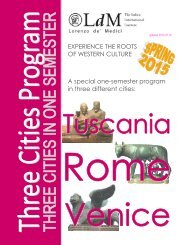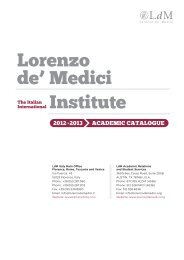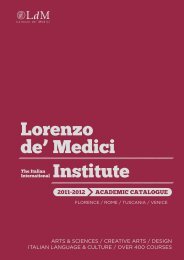aCademiC Catalog 2013-2014 - Lorenzo de Medici
aCademiC Catalog 2013-2014 - Lorenzo de Medici
aCademiC Catalog 2013-2014 - Lorenzo de Medici
You also want an ePaper? Increase the reach of your titles
YUMPU automatically turns print PDFs into web optimized ePapers that Google loves.
FLORENCE<br />
School of Arts & Sciences<br />
image are only two of the aspects stu<strong>de</strong>nts will learn that<br />
are vital to keeping their brand in the news. The course will<br />
further discuss: private, store and national brand labels, core<br />
benefit proposition, luxury and global brand management,<br />
<strong>de</strong>velopment, and extension, as well as franchising, licensing,<br />
patents, tra<strong>de</strong>marks and copyright. Although focused on<br />
fashion the course has applicability to many other product and<br />
service sectors.<br />
Prerequisites: BUS 282 Global Business and Society, or BUS<br />
370 Global Marketing Management, or equivalents<br />
Literature<br />
Survey of Western Literature<br />
LIT 150 F<br />
Cr: 3; Contact hrs: 45<br />
This course is an exploration of major texts from antiquity to<br />
the present that have shaped and expressed Western cultural<br />
traditions (all readings are in English translation). Emphasis<br />
will be placed on the nature of genre, period, and style. The<br />
course also offers the opportunity to <strong>de</strong>velop an awareness of<br />
literature and the skills required to approach and un<strong>de</strong>rstand it.<br />
Italian Crime Fiction<br />
LIT 220 F<br />
Cr: 3; Contact hrs: 45<br />
From the middle of the twentieth century, Italian writers such<br />
as Gadda and Sciascia began to integrate into their novels and<br />
short stories certain aspects of the crime genre, in such a way<br />
that the mystery element became an instrument for analyzing<br />
contemporary Italian realities. By the 1990’s a new generation of<br />
writers such as Camilleri, Ammaniti and Lucarelli had <strong>de</strong>veloped<br />
a specifically Italian approach to an international literary genre,<br />
the “Italian noir”, which aims at revealing unpleasant truths to<br />
a vast audience in an entertaining way. The goal of this course<br />
is to explore some of the most representative works of the<br />
crime fiction genre in contemporary Italian literature, from its<br />
early forms to the present. The study of these works will also<br />
involve an analysis of the strong socio-cultural dimensions<br />
of contemporary Italy, which are the result of a complex<br />
combination of geographical, historical, political and linguistic<br />
factors. These in turn affect different forms of organized and<br />
unorganized crime, and differences in the relationship between<br />
citizens and the law. During the course stu<strong>de</strong>nts will also study<br />
the relationship between Italian crime fiction and its foreign<br />
counterpart, including the works of authors such as Dibdin,<br />
Highsmith and Harris.<br />
Contemporary Italian Novel<br />
LIT 255 F<br />
Cr: 3; Contact hrs: 45<br />
The course covers the Italian contemporary novel concentrating<br />
on the period from 1900 to 1960. It focuses on works in<br />
translation by the main authors (G. D’Annunzio, L. Piran<strong>de</strong>llo,<br />
I. Svevo, F. Tozzi, A. Moravia, C.E. Gadda, C. Pavese, E. Vittorini,<br />
I. Calvino, V. Pratolini, C. Cassola, N. Ginzburg). The professor<br />
will introduce a topic for each class and will select readings<br />
for the stu<strong>de</strong>nts. Stu<strong>de</strong>nts will be invited to discuss those<br />
readings in class. Each stu<strong>de</strong>nt will also be required to <strong>de</strong>velop<br />
an individual project based on the analysis of a complete novel<br />
by one of the authors inclu<strong>de</strong>d in the course program. At the<br />
end of the term, each stu<strong>de</strong>nt will submit a written paper and<br />
an oral presentation in class about his/her own work.<br />
Female Characters in Poetry and Literature<br />
LIT 265 F; Dual listed: GND 265 F<br />
Cr: 3; Contact hrs: 45<br />
The course spans Dante Alighieri’s Beatrice to Madame Bovary.<br />
Comparative analysis of Italian and European literature from<br />
the Middle Ages to the Romantic period will be ma<strong>de</strong>, as well<br />
as love and suffering in female <strong>de</strong>stinies as imagined by male<br />
authors. We will also study the literary roles of women of<br />
different periods.<br />
Prerequisites: LIT 150 Survey of Western Literature, or<br />
equivalent<br />
Florence in the Literary Imagination<br />
LIT 275 F<br />
Cr: 3; Contact hrs: 45<br />
Florence and Tuscany have long occupied a special place in the<br />
Anglo-American literary imagination. Since the Renaissance,<br />
English literature and culture have been permeated by Italian<br />
influences and specifically Tuscan ones. This course will take<br />
the stu<strong>de</strong>nt through the early Tuscan influences on English<br />
literature to then focus, through the study of travel notes,<br />
journals, novels and poems, on the works of those authors,<br />
both British and American, who were inspired by the Tuscan<br />
and Florentine environment. The course will focus on a range<br />
of novelists and poets such as P.B. Shelley, George Eliot,<br />
Elizabeth Browning, D.H. Lawrence, E.M. Forster, Thomas Harris,<br />
Magdalena Nabb, John Mortimer, Sarah Dunant and Salman<br />
Rushdie. Particular attention will also be given to films drawn<br />
from novels with Florentine settings - such as Romola (George<br />
Eliot) and A Room with a View (E.M. Forster).<br />
Many Italies, Other Italies: Mo<strong>de</strong>rn Literary<br />
Representations<br />
LIT 285 F; Dual listed: CLT 285 F<br />
Cr: 3; Contact hrs: 45<br />
Focusing on Italian and Anglo-American literature and some<br />
films, this course will explore the multiple representations of<br />
Italy in the twentieth and twenty-first Century. Far from being<br />
the homogeneous culture that is often perceived from abroad,<br />
Italian culture is a very complex text where many different, and<br />
sometimes conflicting voices and images encounter. This course<br />
aims to look beyond what may be seen as mainstream Italy<br />
to discover peoples often marginalized by dominant cultural<br />
norms and stereotypes. Starting with the critical examination<br />
of the i<strong>de</strong>alized image of Italy propagated by many famous<br />
foreigners throughout the ages, the course will then focus<br />
on the representation of Italy offered by its own writers and<br />
filmmakers. The texts that we will look into encompass many<br />
different peripheral voices that are nonetheless very powerful<br />
and fundamental to a true un<strong>de</strong>rstanding of the Italian culture:<br />
southern Italians, Jewish Italians, emigrants (and Italian<br />
Americans), political dissi<strong>de</strong>nts, women, and more recently,<br />
immigrants from the global East and South are the voices<br />
that have contributed to create a country of intrinsically great<br />
and complex ethnic, religious, linguistic and political diversity;<br />
voices that often remain unheard.<br />
Contemporary European Literature<br />
LIT 300 F<br />
Cr: 3; Contact hrs: 45<br />
The course will focus on European contemporary literature<br />
surveying some of the most important authors of the last<br />
fifty years. Stu<strong>de</strong>nts will become familiar with Italian, English,<br />
Spanish, German and French authors. The course will <strong>de</strong>al with<br />
Nobel Prize winners such as Samuel Beckett (France/Ireland),<br />
Heinrich Böll (Germany), William Golding (England) and with<br />
other important novelists such as Martín Gaite (Spain), Italo<br />
Calvino, Antonio Tabucchi, Alessandro Baricco (Italy), Angela<br />
Carter (England). The course will also take into consi<strong>de</strong>ration<br />
non-European authors who, living in Europe, have had a huge<br />
impact on European literature, among others Jorge Luis Borges<br />
and the Nobel Prize winner Gabriel García Márquez.<br />
Prerequisites: LIT 150 Survey of Western Literature, or<br />
equivalent<br />
Shakespeare’s Italy<br />
LIT 302 F; Dual listed: MCT 302 F<br />
Cr: 3; Contact hrs: 45<br />
Shakespeare, the greatest English-language dramatist of all<br />
time, set approximately one-fourth of his plays in Italian cities<br />
such as ancient Rome, Verona and Venice. In this course, we<br />
will focus on a small selection of his “Italian plays”, including<br />
“Romeo and Juliet” and “The Merchant of Venice”, in or<strong>de</strong>r to<br />
see how Shakespeare combined historical evi<strong>de</strong>nce and fiction,<br />
past and present, for dramatic effect and social commentary.<br />
Stu<strong>de</strong>nts will work with primary sources; for the same purpose<br />
they may also perform selected scenes. This course allows<br />
stu<strong>de</strong>nts to learn more about Shakespeare’s works and<br />
personality, and about relations between Elizabethan literary<br />
70<br />
LdM Aca<strong>de</strong>mic <strong>Catalog</strong> <strong>2013</strong>-<strong>2014</strong>





